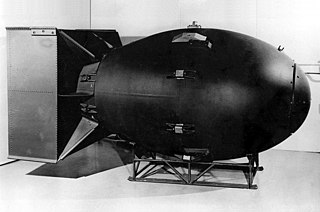
"Fat Man" was the codename for the type of nuclear weapon the United States detonated over the Japanese city of Nagasaki on 9 August 1945. It was the second of the only two nuclear weapons ever used in warfare, the first being Little Boy, and its detonation marked the third nuclear explosion in history. It was built by scientists and engineers at Los Alamos Laboratory using plutonium from the Hanford Site, and was dropped from the Boeing B-29 Superfortress Bockscar piloted by Major Charles Sweeney.

Little Boy was the name of the type of atomic bomb used in the bombing of the Japanese city of Hiroshima on 6 August 1945 during World War II, making it the first nuclear weapon used in warfare. The bomb was dropped by the Boeing B-29 Superfortress Enola Gay piloted by Colonel Paul W. Tibbets Jr., commander of the 509th Composite Group, and Captain Robert A. Lewis. It exploded with an energy of approximately 15 kilotons of TNT (63 TJ) and caused widespread death and destruction throughout the city. The Hiroshima bombing was the second nuclear explosion in history, after the Trinity nuclear test.

The Manhattan Project was a program of research and development undertaken during World War II to produce the first nuclear weapons. It was led by the United States in collaboration with the United Kingdom and with support from Canada. From 1942 to 1946, the project was under the direction of Major General Leslie Groves of the U.S. Army Corps of Engineers. Nuclear physicist J. Robert Oppenheimer was the director of the Los Alamos Laboratory that designed the bombs. The Army component was designated the Manhattan District, as its first headquarters were in Manhattan; the name gradually superseded the official codename, Development of Substitute Materials, for the entire project. The project absorbed its earlier British counterpart, Tube Alloys. The Manhattan Project grew rapidly and employed nearly 130,000 people at its peak and cost nearly US$2 billion. Over 80 percent of the cost was for building and operating the plants that produced the fissile material for the weapons. Research and production took place at more than 30 sites across the United States, the United Kingdom, and Canada.

Los Alamos National Laboratory is one of the sixteen research and development laboratories of the United States Department of Energy (DOE), located a short distance northwest of Santa Fe, New Mexico, in the American southwest. Best known for its central role in helping develop the first atomic bomb, LANL is one of the world's largest and most advanced scientific institutions.

Trinity was the code name of the first detonation of a nuclear weapon, conducted by the United States Army at 5:29 a.m. MWT on July 16, 1945, as part of the Manhattan Project. The test was of an implosion-design plutonium bomb, nicknamed the "gadget", of the same design as the Fat Man bomb later detonated over Nagasaki, Japan, on August 9, 1945. Concerns about whether the complex Fat Man design would work led to a decision to conduct the first nuclear test. The code name "Trinity" was assigned by J. Robert Oppenheimer, the director of the Los Alamos Laboratory, inspired by the poetry of John Donne.

Tube Alloys was the research and development programme authorised by the United Kingdom, with participation from Canada, to develop nuclear weapons during the Second World War. Starting before the Manhattan Project in the United States, the British efforts were kept classified, and as such had to be referred to by code even within the highest circles of government.
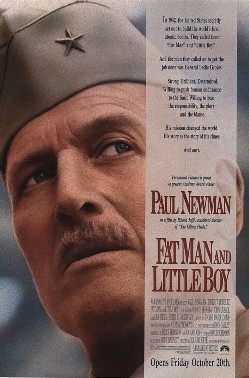
Fat Man and Little Boy is a 1989 American epic historical war drama film directed by Roland Joffé, who co-wrote the script with Bruce Robinson. The story follows the Manhattan Project, the secret Allied endeavor to develop the first nuclear weapons during World War II. The film is named after "Little Boy" and "Fat Man", the two bombs dropped on the Japanese cities of Hiroshima and Nagasaki, respectively.

Seth Henry Neddermeyer was an American physicist who co-discovered the muon, and later championed the implosion-type nuclear weapon while working on the Manhattan Project at the Los Alamos Laboratory during World War II.

Jack W. Aeby was an American environmental physicist most famous for having taken the only well-exposed color photograph of the first detonation of a nuclear weapon on July 16, 1945, at the Trinity nuclear test site in New Mexico.

The Metallurgical Laboratory was a scientific laboratory at the University of Chicago that was established in February 1942 to study and use the newly discovered chemical element plutonium. It researched plutonium's chemistry and metallurgy, designed the world's first nuclear reactors to produce it, and developed chemical processes to separate it from other elements. In August 1942 the lab's chemical section was the first to chemically separate a weighable sample of plutonium, and on 2 December 1942, the Met Lab produced the first controlled nuclear chain reaction, in the reactor Chicago Pile-1, which was constructed under the stands of the university's old football stadium, Stagg Field.
John Aristotle Phillips is a U.S. entrepreneur specializing in political campaigns, who became famous for attempting to design a nuclear weapon while a student.
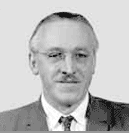
Jordan Carson Mark was a Canadian-American mathematician best known for his work on developing nuclear weapons for the United States at the Los Alamos National Laboratory. Mark joined the Manhattan Project in 1945, and continued to work at Los Alamos under the leadership of Norris Bradbury after World War II ended. He became the leader of the Theoretical Division at the laboratory in 1947, a position he held until 1973. He oversaw the development of new weapons, including the hydrogen bomb in the 1950s. On the hydrogen bomb project he was able to bring together experts like Edward Teller, Stanislaw Ulam and Marshall Holloway despite their personal differences.
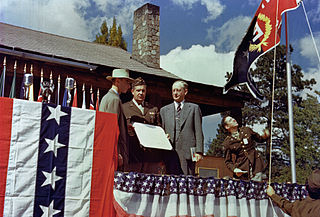
The Manhattan Project was a research and development project that produced the first atomic bombs during World War II. It was led by the United States with the support of the United Kingdom and Canada. From 1942 to 1946, the project was under the direction of Major General Leslie Groves of the US Army Corps of Engineers. The Army component of the project was designated the Manhattan District; "Manhattan" gradually became the codename for the entire project. Along the way, the project absorbed its earlier British counterpart, Tube Alloys. The Manhattan Project began modestly in 1939, but grew to employ more than 130,000 people and cost nearly US$2 billion. Over 90% of the cost was for building factories and producing the fissionable materials, with less than 10% for development and production of the weapons.

Atomic spies or atom spies were people in the United States, the United Kingdom, and Canada who are known to have illicitly given information about nuclear weapons production or design to the Soviet Union during World War II and the early Cold War. Exactly what was given, and whether everyone on the list gave it, are still matters of some scholarly dispute. In some cases, some of the arrested suspects or government witnesses had given strong testimonies or confessions which they recanted later or said were fabricated. Their work constitutes the most publicly well-known and well-documented case of nuclear espionage in the history of nuclear weapons. At the same time, numerous nuclear scientists wanted to share the information with the world scientific community, but this proposal was firmly quashed by the United States government. It is worth noting that many scientists who worked on the Manhattan Project were deeply conflicted about the ethical implications of their work, and some were actively opposed to the use of nuclear weapons.

"Thin Man" was the code name for a proposed plutonium gun-type nuclear bomb that the United States was developing during the Manhattan Project. Its development was abandoned when it was discovered that the spontaneous fission rate of nuclear reactor-bred plutonium was too high for use in a gun-type design due to the high concentration of the isotope plutonium-240 in the plutonium produced at the Clinton Engineer Works.
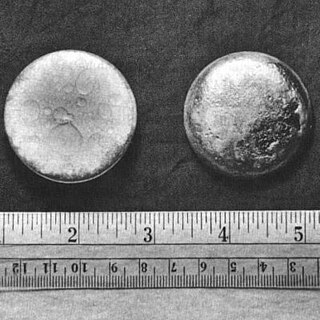
Plutonium is a chemical element; it has symbol Pu and atomic number 94. It is an actinide metal of silvery-gray appearance that tarnishes when exposed to air, and forms a dull coating when oxidized. The element normally exhibits six allotropes and four oxidation states. It reacts with carbon, halogens, nitrogen, silicon, and hydrogen. When exposed to moist air, it forms oxides and hydrides that can expand the sample up to 70% in volume, which in turn flake off as a powder that is pyrophoric. It is radioactive and can accumulate in bones, which makes the handling of plutonium dangerous.
The Atomic Heritage Foundation (AHF) is a nonprofit organization originally based in Washington, DC, dedicated to the preservation and interpretation of the Manhattan Project, the Atomic Age, and its legacy. Founded by Cynthia Kelly in 2002, the Foundation's stated goal is, "to provide the public not only a better understanding of the past but also a basis for addressing scientific, technical, political, social and ethical issues of the 21st century." AHF works with Congress, the Department of Energy, the National Park Service, state and local governments, nonprofit organizations and the former Manhattan Project communities to preserve and interpret historic sites and develop useful and accessible educational materials for veterans, teachers, and the general public. In June 2019, the Atomic Heritage Foundation and the National Museum of Nuclear Science & History signed an agreement that granted stewardship of the Atomic Heritage Foundation website and all of the AHF's physical collections to the museum. The Atomic Heritage Foundation website is now run by the National Museum of Nuclear Science & History. Additionally, the museum now houses the Atomic Heritage Foundation's physical collections which have been integrated into the Nuclear Museum's own collection.
Chaudhry Abdul Majeed was a Pakistani nuclear chemist, nuclear weapon and reactor expert. He is known as one of the pioneers of Pakistan's nuclear weapon programme, and has worked closely with former Pakistan Atomic Energy Commission (PAEC) Chairman Munir Ahmad Khan's plutonium reprocessing project. He rose to prominence when he was apprehended by Pakistan's intelligence agencies in a joint operation in late October 2001. Majeed was also one of the founding members of Sultan Bashiruddin Mahmood's Ummah Tameer-e-Nau organisation; an NGO which caused an international embarrassment for Pakistan.
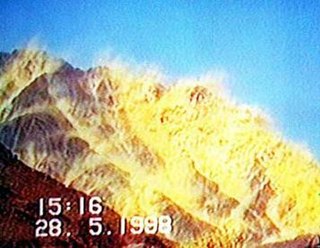
Project-706, also known as Project-786 was the codename of a research and development program to develop Pakistan's first nuclear weapons. The program was initiated by Prime Minister Zulfiqar Ali Bhutto in 1974 in response to the Indian nuclear tests conducted in May 1974. During the course of this program, Pakistani nuclear scientists and engineers developed the requisite nuclear infrastructure and gained expertise in the extraction, refining, processing and handling of fissile material with the ultimate goal of designing a nuclear device. These objectives were achieved by the early 1980s with the first successful cold test of a Pakistani nuclear device in 1983. The two institutions responsible for the execution of the program were the Pakistan Atomic Energy Commission and the Kahuta Research Laboratories, led by Munir Ahmed Khan and Abdul Qadeer Khan respectively. In 1976 an organization called Special Development Works (SDW) was created within the Pakistan Army, directly under the Chief of the Army Staff (Pakistan) (COAS). This organization worked closely with PAEC and KRL to secretly prepare the nuclear test sites in Baluchistan and other required civil infrastructure.
Harrison Scott Brown was an American nuclear chemist and geochemist. He was a political activist, who lectured and wrote on the issues of arms limitation, natural resources and world hunger.
















